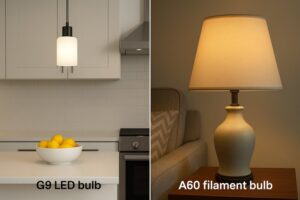You specify new LED lights for a project, only to hear complaints of headaches and eye strain. Choosing the wrong lights creates discomfort and harms productivity, reflecting poorly on your judgment and the quality of the space.
High-quality LED lighting is perfectly safe for your eyes. The real health risks come from low-quality products that produce invisible flicker, harsh glare, and unsuitable colors. Therefore, selecting a well-designed, reliable LED is crucial for visual comfort and eye health.

This topic is deeply important to me. A few years ago, a project manager for a large office renovation in the Netherlands reached out. He had installed thousands of new LED panel lights from a different supplier and was facing a revolt. "Wallson," he said, "my team is getting headaches. The light feels... harsh. We followed the brightness standards, but something is wrong." He was worried about his team's health and the project's success. His problem wasn't about the type of light (LED), but the quality of it. This highlights that for business owners and managers, choosing the right light is a health and safety decision, not just an operational one.
Isn't the Blue Light from LEDs Dangerous?
You read alarming headlines about "blue light toxicity" from LEDs causing permanent eye damage. This fear makes you hesitate, worried that choosing modern, efficient lighting could have unintended negative consequences for you or your clients.
The amount of blue light from general LED lighting is not considered dangerous for your eyes by most experts. It is comparable to or even less than the blue light you receive from natural daylight. The primary health concern regarding blue light is its effect on your sleep cycle, not eye damage.
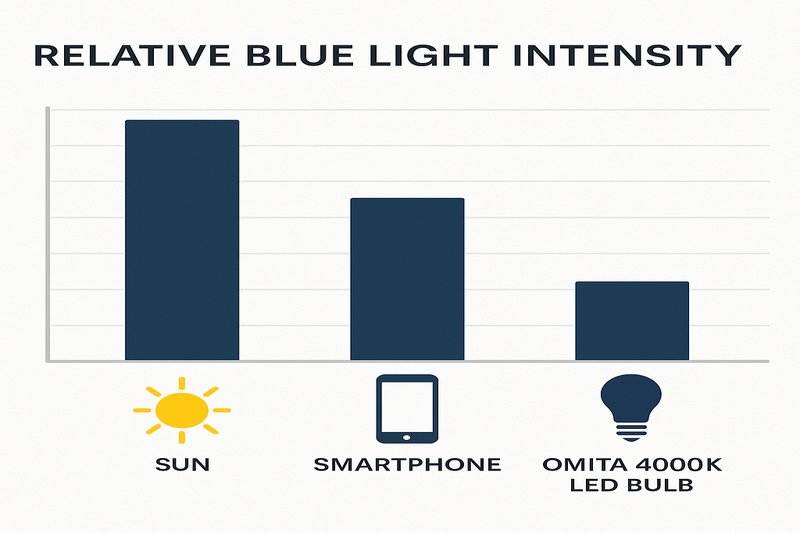
The "blue light hazard" is a real phenomenon, but it is frequently misunderstood in popular media. This term refers to potential photochemical damage to the retina from extremely high-intensity, direct exposure, like staring at the sun. However, the level of blue light emitted from consumer and commercial LEDs is far below the safety thresholds defined by international standards like IEC 62471. As a responsible manufacturer, we at Omita engineer our products to strictly adhere to these safety standards. The panic over LEDs causing eye damage is largely misplaced. A person will receive a far greater dose of blue light during a thirty-minute walk outside than they will from working in a well-lit office for eight hours. The real conversation should be about using the right color of light at the right time to support our natural body clock, rather than fearing all blue light as inherently toxic.
What is a Flicker and Why Should You Care About It?
The new lights are installed and seem fine, but people feel a sense of unease or fatigue in the space. This invisible problem, flicker, can cause subliminal stress, leading to real neurological symptoms like headaches, blurred vision, and eye strain.
Flicker is a rapid, often invisible, fluctuation in a light's output caused by a poor-quality electronic driver. While your eyes may not see it consciously, your brain detects it, leading to eye fatigue, headaches, and reduced concentration.
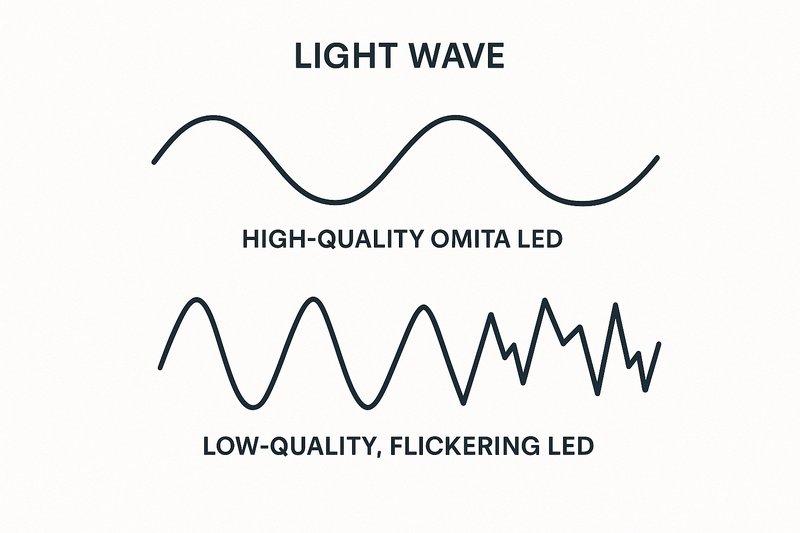
Flicker is one of the most significant differentiators between a high-quality LED product and a cheap, unreliable one. The problem originates in the electronic driver inside the bulb. This driver's job is to convert the alternating current (AC) from the electrical outlet into the stable direct current (DC) that the LED chip requires to function. Cheap, poorly designed drivers don't smooth out this current properly, causing the light to flash hundreds of times per second. Even if it's too fast to see, your pupils are trying to react to it constantly, which puts immense strain on your eye muscles and nervous system. My customer "Jacky" in America knows this pain point well; he needs to guarantee a comfortable experience in the homes that use his products. A simple test you can perform is to look at a light through your smartphone's camera; if you see dark bands running across the screen, you are seeing evidence of high flicker. At Omita, we focus intensely on perfecting our drivers to deliver clean, constant power for a smooth, flicker-free light.
How Can You Reduce Uncomfortable Glare?
You install bright, efficient lights, but the space feels harsh and clinical instead of warm and inviting. Glare creates visual noise, forcing people to squint and strain their eyes, which turns a well-lit room into an unpleasant one.
Reduce glare by choosing frosted or opal bulbs, using well-designed fixtures that shield the direct light source, and aiming light indirectly. Using multiple, lower-lumen light sources instead of one harsh central light is a key strategy for visual comfort.
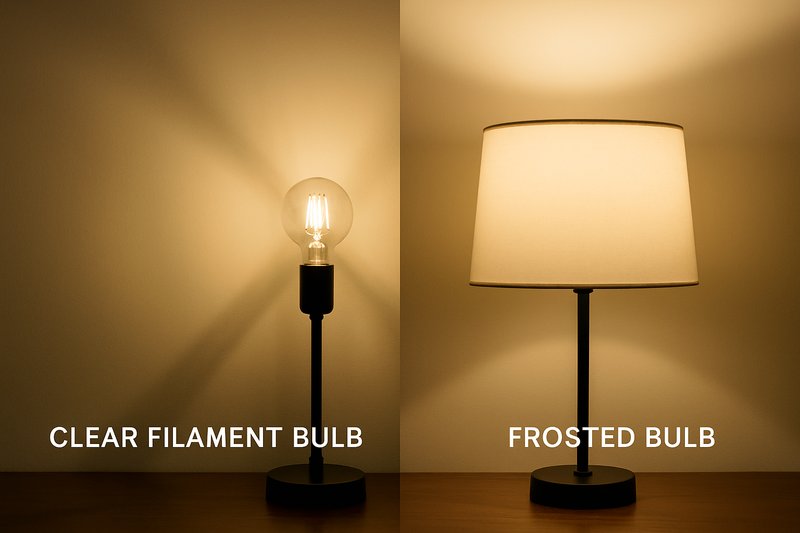
Glare is simply light that is shining in the wrong place. It's one of the most common complaints in lighting design, and thankfully, it's one of the easiest to solve with careful product selection and planning. There are two main types: discomfort glare, which is annoying and causes eye strain, and disability glare, which is so intense it actually prevents you from seeing properly. For business owners and designers, controlling glare is essential for creating a space that feels not just functional, but also comfortable and premium. For example, in a retail environment, glare can make products look unappealing and drive customers away. In an office, it reduces productivity. Based on our 30 years of experience, we recommend a few simple strategies. First, for any fixture where the bulb is visible, choose a frosted or opal glass finish like those available on our A60 or G95 bulbs. Second, use fixtures with shades or deep baffles that direct light downward and shield it from the viewer's direct line of sight.
What Key Features Define an "Eye-Friendly" LED Bulb?
You understand the problems of blue light, flicker, and glare, but how do you select the right product? The technical specifications on the box can be confusing, making it hard to choose with confidence.
A truly eye-friendly LED excels in three areas: it has a high Color Rendering Index (CRI > 90) for accurate color, it is certified flicker-free, and it is available in a range of warm color temperatures (2200K-3000K).
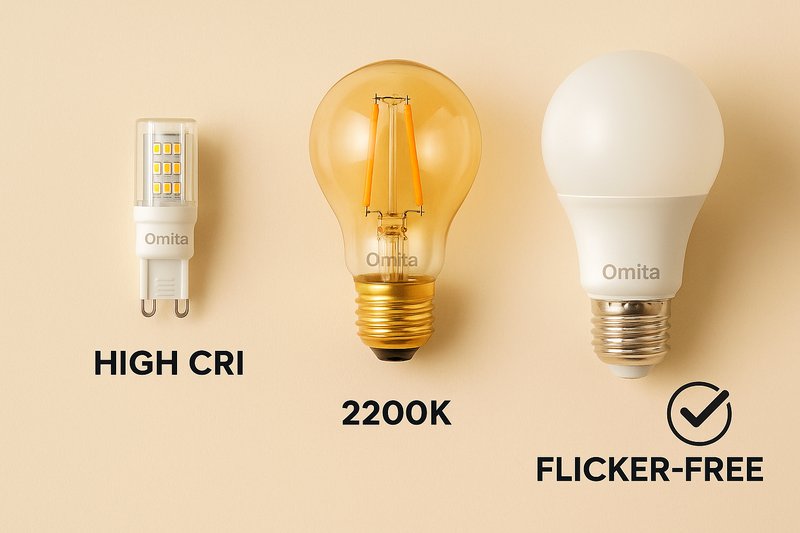
When you are sourcing lighting, it is helpful to have a simple checklist. Beyond just the lumens and watts, these are the quality markers that directly impact eye health and visual comfort.
Your Buyer's Checklist for Eye-Friendly LEDs
| Feature | What It Is | Why It Matters for Eye Health | Omita's Standard |
|---|---|---|---|
| High CRI (>90)1 | A measure of how accurately a light source reveals the true colors of objects. | Low CRI makes colors look dull and washed out. Your brain has to work harder to interpret what it sees, causing subtle, long-term strain. | We aim for CRI 90+ in our premium lines. |
| Flicker-Free Driver2 | An advanced electronic driver that delivers smooth, constant power to the LED chip. | Eliminates the invisible pulsations that lead to headaches, eye fatigue, and neurological stress. This is a critical quality feature. | Our core technology focus is on flicker-free drivers. |
| Warm CCT Options | The availability of bulbs with a warm color temperature (Kelvin), especially 2200K to 2700K. | Warm light contains very little blue light, making it ideal for evening use. It prevents eye strain in low light and protects your natural sleep cycle. | We have a wide range from 2200K to 6500K. |
By prioritizing these three features, you move beyond basic illumination and start providing high-quality visual environments. For any buyer or product manager, specifying these features is a clear way to provide a superior, healthier product to your own customers.
Conclusion
The right LED is more than a light source; it's a commitment to visual comfort and health. Choosing quality LEDs that minimize flicker, glare, and blue light exposure actively protects our eyes.





